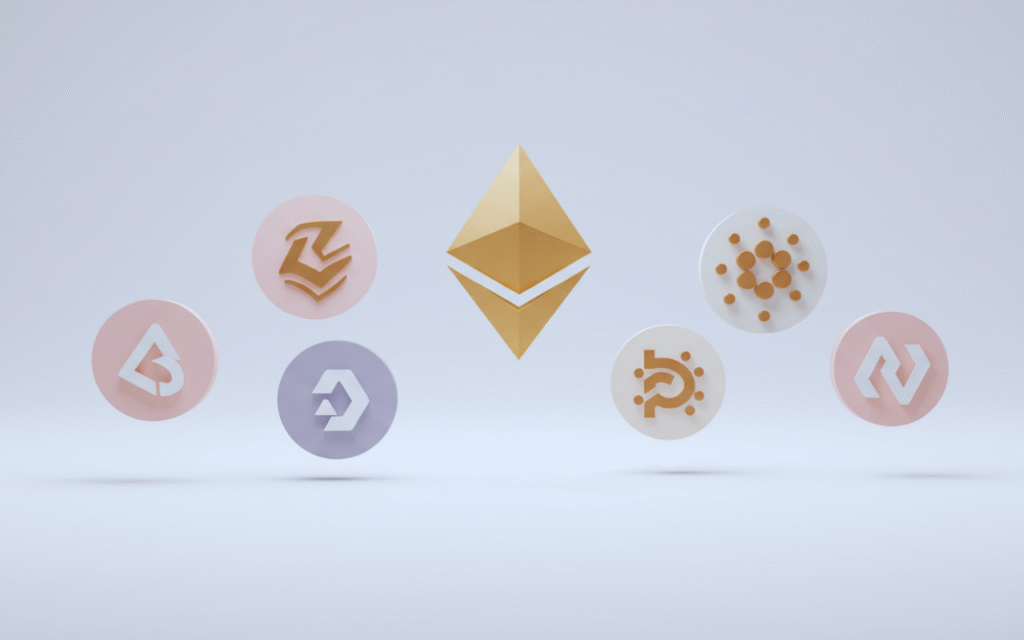Ethereum has long been the king of decentralized applications (dApps) and smart contracts, but as the blockchain space continues to evolve, several platforms have risen to challenge its dominance. With advancements in scalability, transaction speed, and energy efficiency, these competitors are carving out their own niches in the blockchain ecosystem. In 2025, the competition is fiercer than ever. Let’s take a look at the top five blockchain platforms giving Ethereum a run for its money.

1. [Solana] The Speed Demon
Solana has been making waves for years now, and it’s not slowing down. Known for its lightning-fast transaction speeds and incredibly low fees, Solana is a favorite among developers and users alike. By 2025, Solana’s ecosystem has grown significantly, hosting a wide range of dApps, from gaming to decentralized finance (DeFi).
What sets Solana apart is its unique Proof of History (PoH) consensus mechanism, which allows the network to process thousands of transactions per second (TPS). While Ethereum has made strides with its transition to Ethereum 2.0 and Proof of Stake (PoS), Solana’s scalability remains one of the best in the industry. For users who prioritize speed and affordability, Solana continues to be a top choice.
2. [Cardano] The Academic Powerhouse
Cardano has always taken a methodical, research-driven approach to blockchain development, and by 2025, this strategy has paid off. With a focus on security, scalability, and sustainability, Cardano has built a reputation as one of the most reliable platforms in the space.
Thanks to its Ouroboros PoS consensus protocol, Cardano is both energy-efficient and secure. Its emphasis on peer-reviewed research ensures that every upgrade is thoroughly vetted before implementation. In 2025, Cardano’s ecosystem is thriving, with a growing number of dApps and partnerships across industries like healthcare, education, and supply chain management.
While it may not match Ethereum’s sheer volume of activity yet, Cardano appeals to those who value a thoughtful and sustainable approach to blockchain technology. Its focus on peer-reviewed research, scalability, and environmental consciousness makes it an attractive choice for developers and investors seeking long-term potential and innovation in the crypto space.
3. [Polkadot] The Interoperability Champion
Polkadot has always stood out for its focus on interoperability, and by 2025, it’s a major player in connecting different blockchains. Created by Ethereum co-founder Dr. Gavin Wood, Polkadot allows multiple blockchains (called parachains) to operate seamlessly together within its ecosystem.
This interoperability makes Polkadot an attractive option for developers who want to create specialized blockchains without sacrificing connectivity to the broader crypto world. Its shared security model also ensures that parachains remain secure while benefiting from the scalability of the network.
As more projects recognize the importance of cross-chain communication, Polkadot’s role as a bridge between blockchains solidifies its position as one of Ethereum’s strongest competitors. With its unique architecture and ability to foster interoperability, Polkadot continues to attract developers and businesses seeking scalable, efficient, and collaborative blockchain solutions, paving the way for a more interconnected and innovative Web3 ecosystem.
4. [Avalanche] The Customization Expert
Avalanche is another platform that has been gaining momentum thanks to its focus on speed and customization. By 2025, Avalanche has established itself as a go-to solution for developers looking to create tailor-made blockchains for specific applications.
Avalanche’s unique architecture allows developers to deploy their own subnets, customizable blockchains that can operate independently while still being part of the Avalanche ecosystem. This flexibility makes it ideal for enterprises and projects that require specific features or compliance measures.
With near-instant transaction finality and low fees, Avalanche has become a favorite for DeFi projects and NFT marketplaces. Its ability to cater to diverse use cases ensures it remains a strong competitor to Ethereum. Furthermore, its growing ecosystem of dApps, partnerships, and developer-friendly tools highlights its commitment to innovation and scalability, making it an appealing choice for both established projects and new ventures alike.
5. [Binance Smart Chain] The Accessible Giant
Binance Smart Chain (now often referred to as BNB Chain) has maintained its position as one of the most user-friendly blockchain platforms. By 2025, BSC continues to attract developers and users with its low fees and compatibility with Ethereum’s Virtual Machine (EVM).
BSC’s close ties to Binance, one of the largest cryptocurrency exchanges in the world, give it a significant advantage in terms of visibility and user adoption. Its extensive ecosystem includes everything from DeFi protocols to gaming platforms and NFT projects. While critics have raised concerns about centralization in BSC’s governance model, it remains an attractive choice for those looking for a fast and cost-effective alternative to Ethereum.
Conclusion
Ethereum remains a powerhouse in the blockchain world, but these five platforms, Solana, Cardano, Polkadot, Avalanche, and Binance Smart Chain are proving that there’s room for competition. Each offers unique features and advantages that cater to different needs within the crypto space.
As we move further into 2025, it’s clear that the blockchain ecosystem is becoming more diverse and innovative than ever before. Whether you’re a developer looking for the perfect platform or an investor exploring opportunities, these Ethereum competitors are worth keeping an eye on.


![[Blockchain Beyond Cryptocurrency] The Untapped Potential Across Industries](https://mineatech.com/wp-content/uploads/2025/08/blockchain-beyond-cryptocurrency-the-untapped-potential-across-industries-348x215.png)
![What Is a Blockchain Consensus Algorithm? [Explained Simply]](https://mineatech.com/wp-content/uploads/2025/08/what-is-a-blockchain-consensus-algorithm-explained-simply-348x215.png)